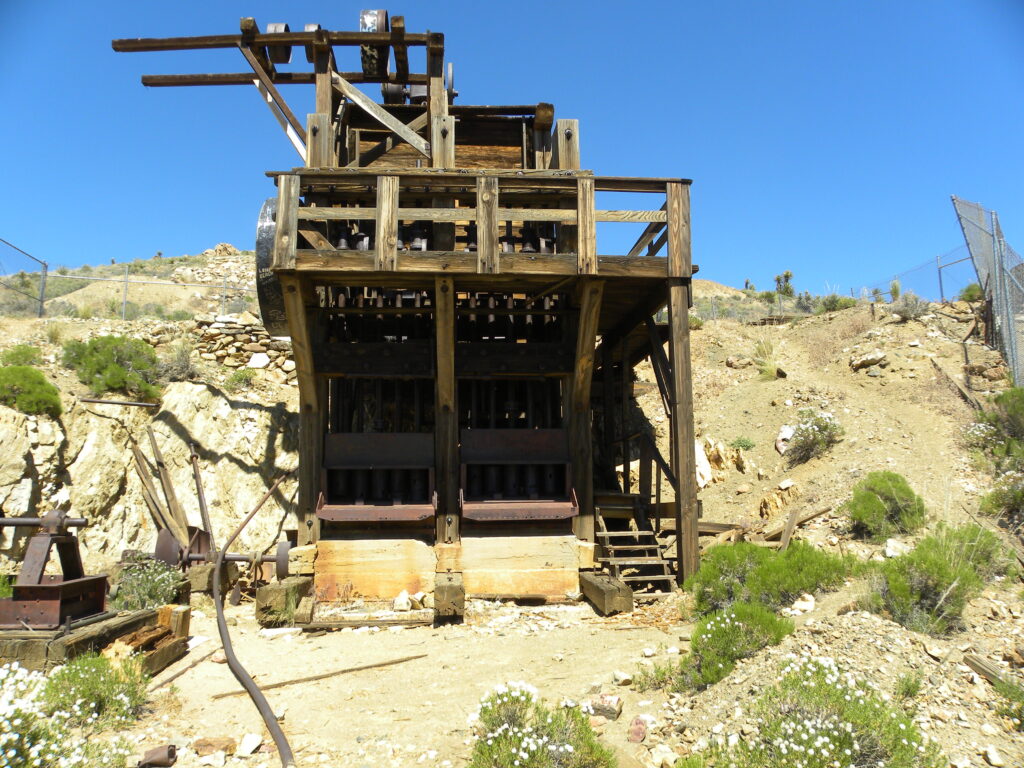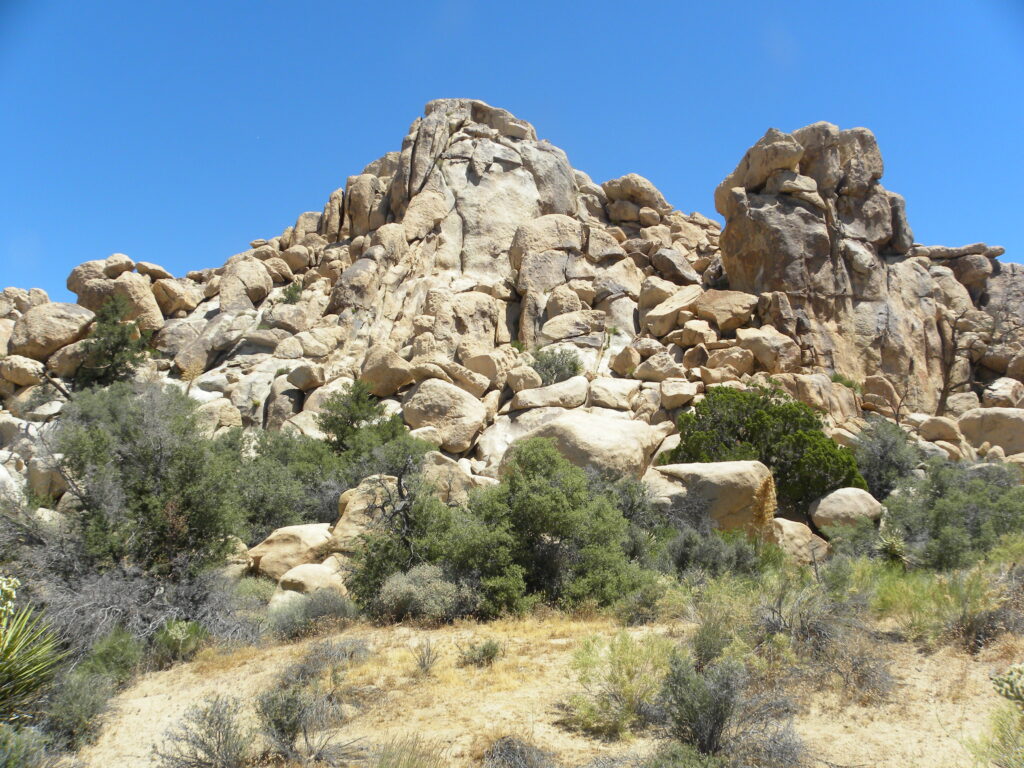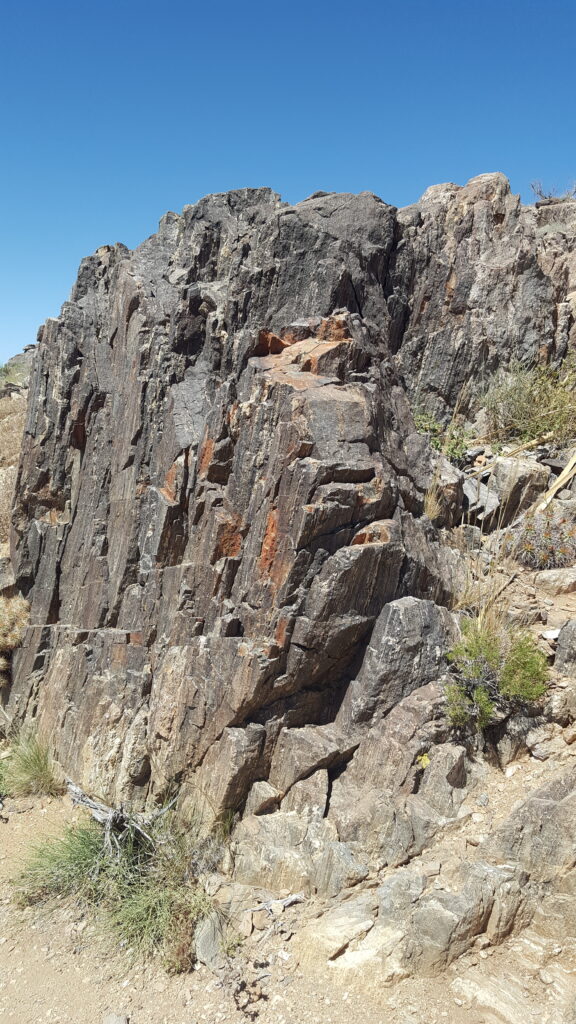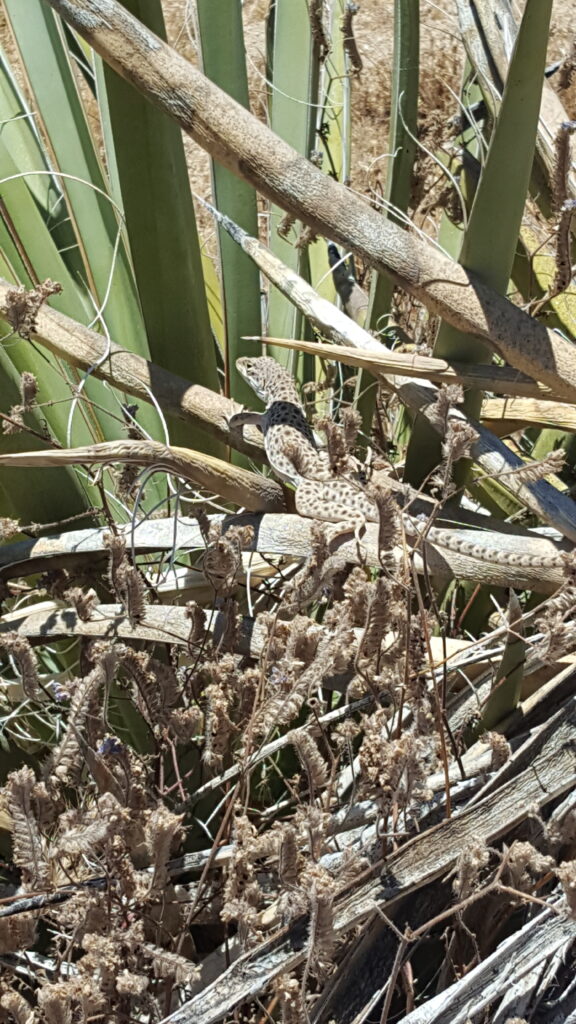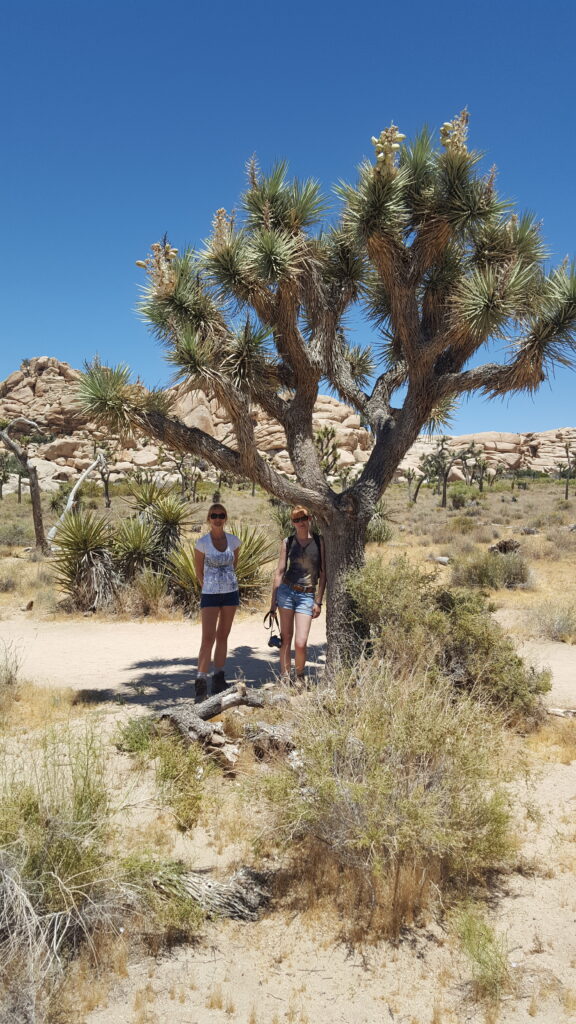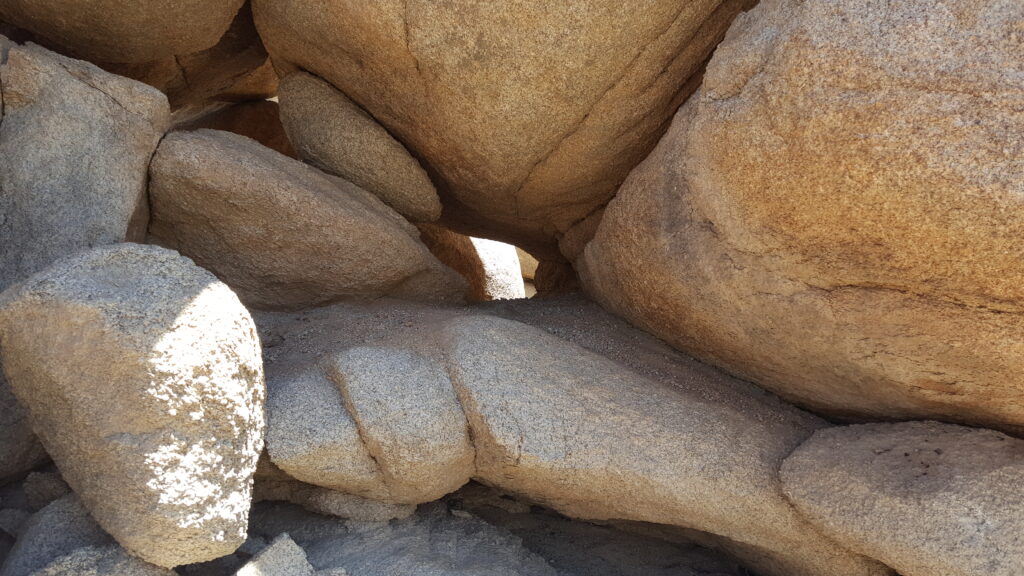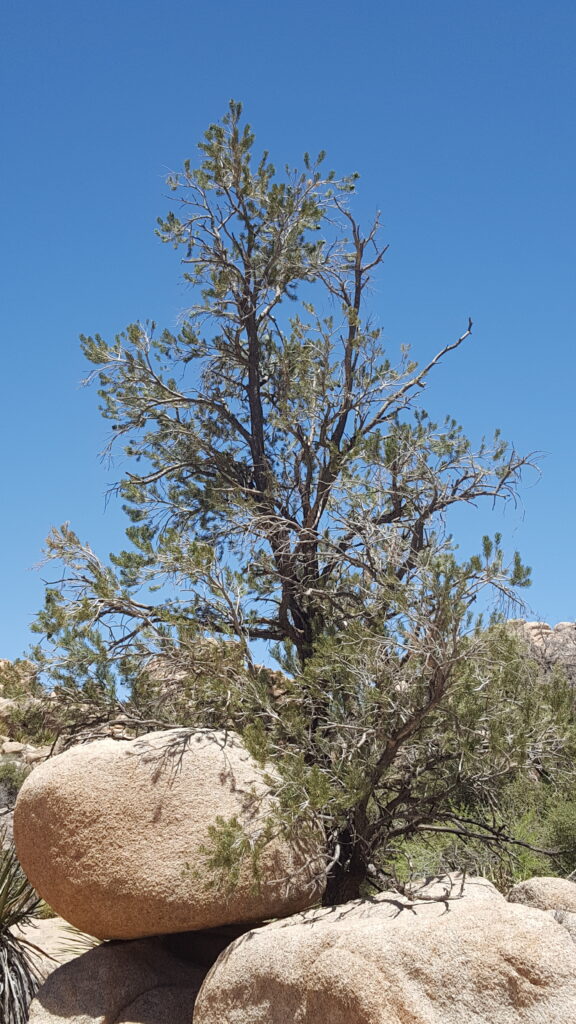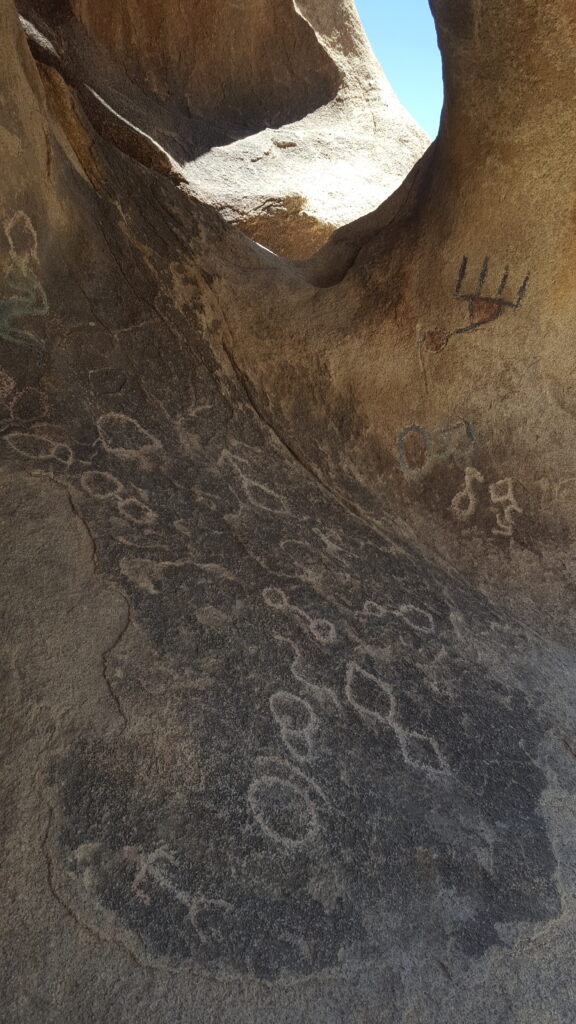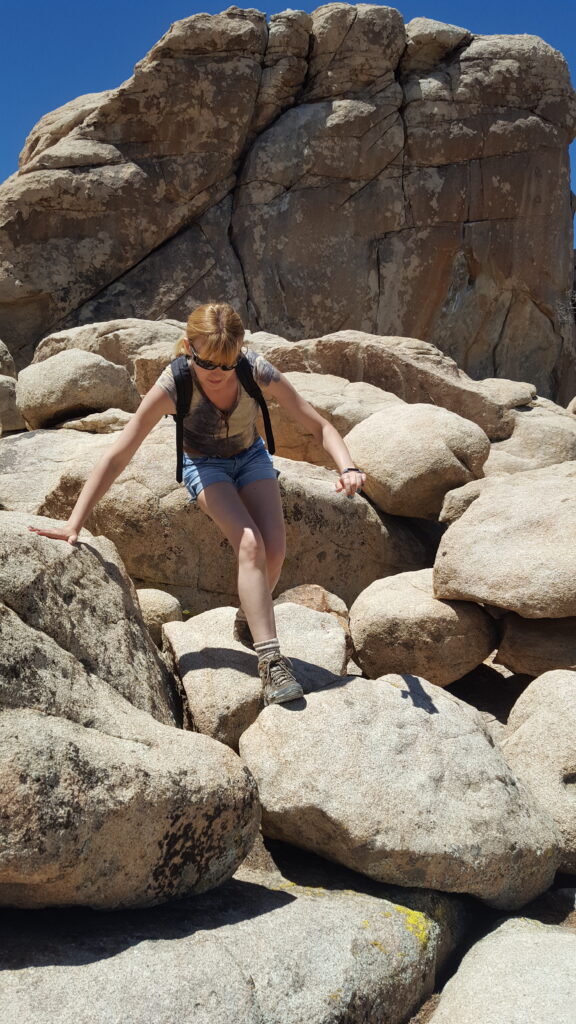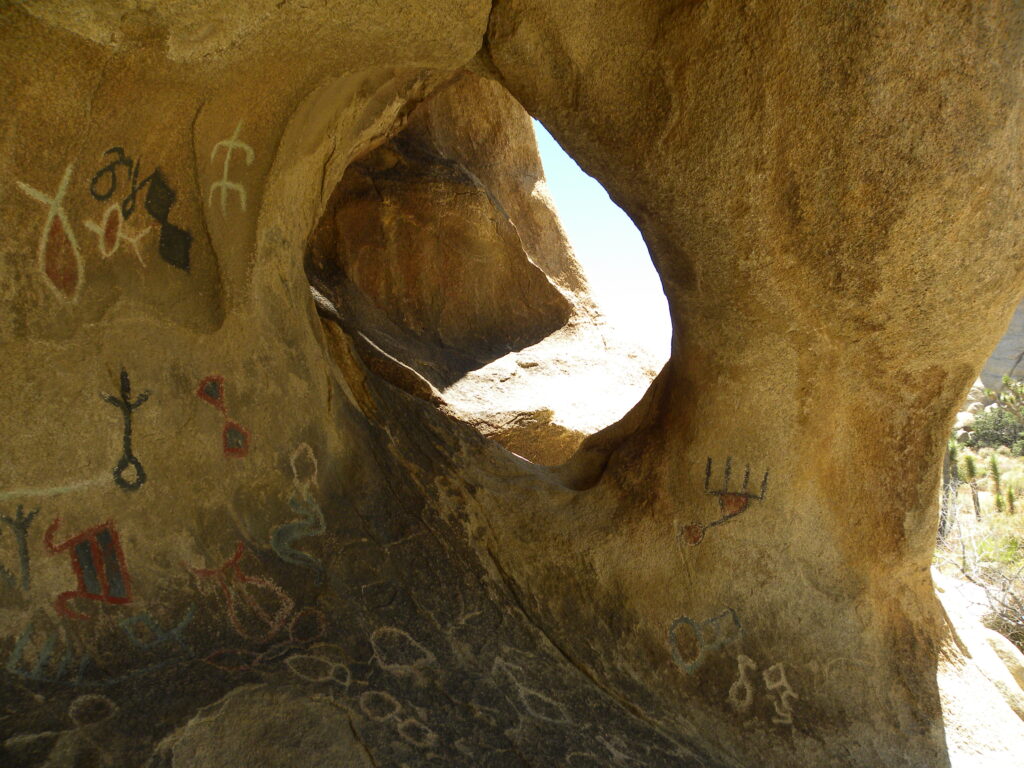Discovering the world / Odkrywając świat, Interesting facts / Ciekawostki, Traveler's guide / Podróznicze porady
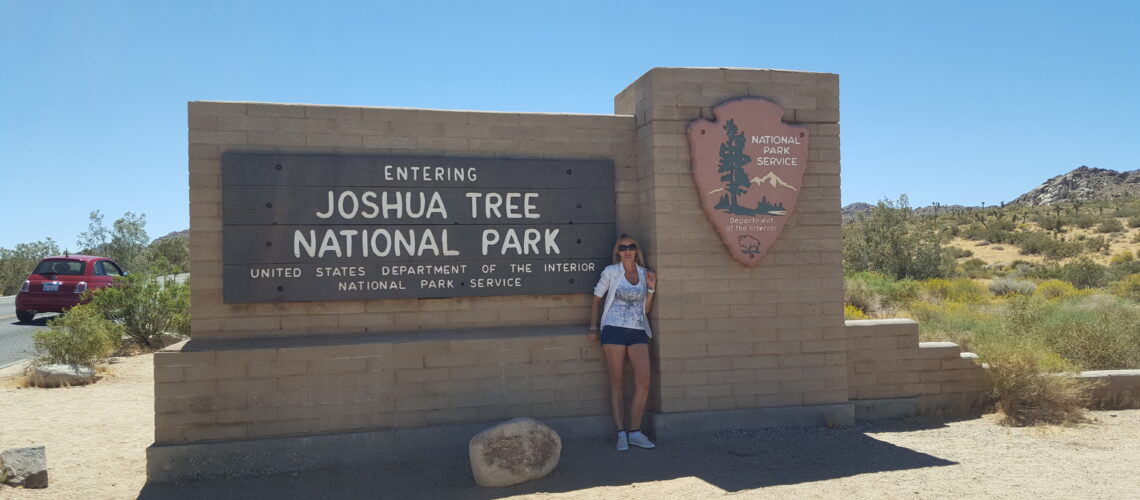
January 15, 2022
Joshua Tree National Park
Joshua Tree National Park is located in southeastern California, just 140 miles (225 kilometers) from Los Angeles and 49 miles (78 kilometers) from Palm Springs. It is definitely not one of the most famous parks in the USA. So is it worth visiting? In my opinion, yes, even if you are not a fan of rock climbing. For climbers, however, Joshua Tree is a must-see. After all, there are over 8,000 climbing routes here.
Joshua Tree and two deserts
Joshua Tree National Park is where two deserts (Mojave and Colorado) meet. In addition to sand, there are countless rock formations and plants that the park owes its name to. Joshua Tree is a short-leaved yucca. Small, medium, large, twisted and spiky, branchy and less plump. Wherever we look, Joshua trees are there. And it is worth taking a look at them, because they are found in nature mainly in the states of Arizona, California, Nevada and Utah.
The park can easily be visited by car, with stops at the main attractions. Asphalt roads lead from one to the other.
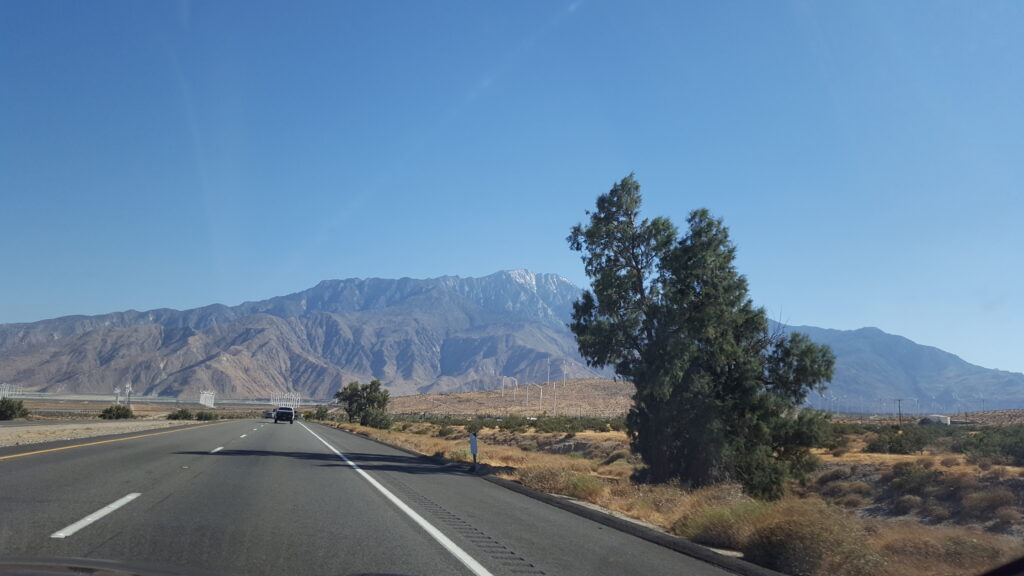
Cycling is becoming more and more common. This is due to the fact that this mean of transport can be easily packed into the car, it gives you an insight into areas inaccessible to the car and too distant for exploration on foot. Contact with nature is more complete, in more desolate places, providing an additional opportunity to stay physically fit.
You can also spend the night in Joshua Tree (there are nine places where you can pitch a tent) to admire the starry sky in summer. According to some, it’s the best place in the US to stare at the stars. And after a night spent under the starry sky, it is worth wandering along one of the trails. And there are almost 30 of them – with varying degrees of difficulty.
There are only three ways visitors can enter the park: from Yucca Valley in the west, Twentynine Palms in the north, and Cottonwood Springs in the south.
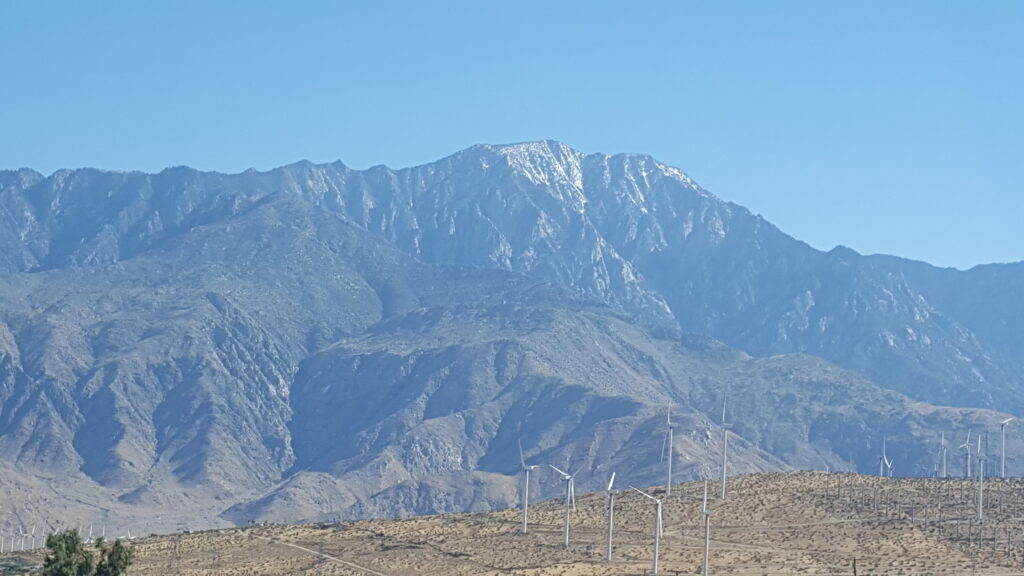
The best way to get to know the Park is to enter the North Entrance Station, visit the Oasis Visitor Center, continue to Cholla Cactus Garden and Ocotillo Patch, reverse, short walk to Arch Rock, drive through Jumbo Rocks and Sheep Pass to the West Entrance of Joshua Tree. Such an optimal route, with a trip to the Keys View observation deck, is only 100 km long, introducing you to an interesting fragment of the “low desert”.
Not far from the northern entrance there is a green, palm-lined oasis (Oasis of Mara), once used by Indians and gold-diggers as a place to hide from the scorching sun. Several kilometers behind the entrance to the Park there is an interesting “garden” of cholla cacti (Cholla Cactus Garden). It is worth taking a short walk through this enchanting landscape, following the sketch of the path along the road.
Three kilometers to the south is another example of a grove, this time looking like the raised broomstick of owtillo (Ocotillo Patch) cactus. Most of the year they are bare, spiked stalks, but in March and April they grow green leaves and bright red flowers loved by hummingbirds migrating from Mexico! This part of the Park clearly represents the Colorado desert.
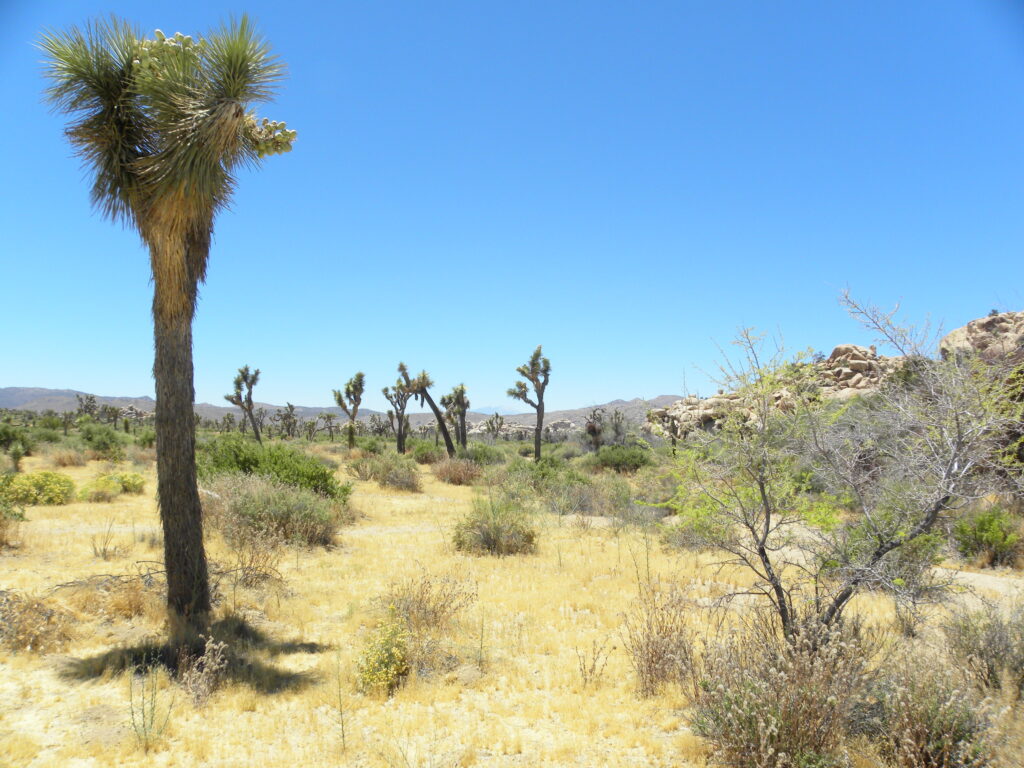
We turn north to stop at the White Tank campsite, where a short path leads to the Arch Rock with a detailed description of the geological forces forming the area. Even more interesting examples of rock formations can be found among the huge granite boulders (Jumbo Rocks), crowded with beginner climbers. This is the most photogenic part of the Park, considering that a bit further, in the Hidden Valley, the rocks resemble fantastic animals and human faces. All this among the Joshua trees in their fullest development. A 2-kilometer trail leads through the Hidden Valley, but requires some rock climbing. You are only 10 km from the west exit of the Park, but if you have time and the smog from Los Angeles does not obstruct the visibility, it is worth going up Keys View hill, from where you can see the panorama of Palm Springs, Salton Sea, mountains and deserts stretching on south far into Mexico.
Rocks and plants are not all that this Park has to offer. If you stay until dusk, you can hear the seemingly dead desert come alive. There is so little water that only the organisms most adapted to this climate are able to survive, being active mainly at night. Wandering along the paths you can come across coyotes, hares, skunks, desert turtles, numerous lizards, rattlesnakes, tarantula spiders, rats, and birds: hummingbirds, buzzards, owls, vultures and piebald puppies (roadrunner). Apparently, it is easy to spot desert turtles here.
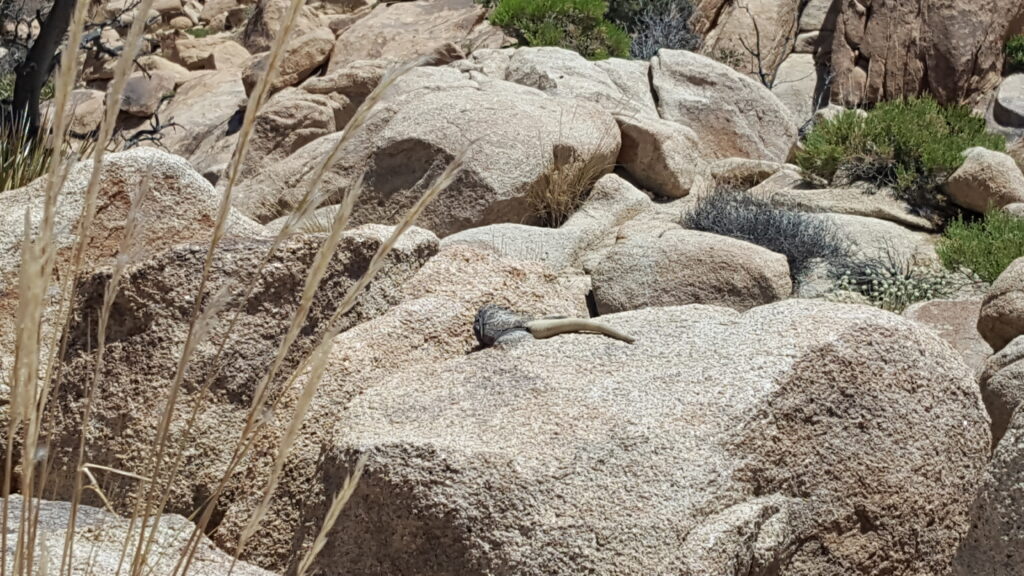
Joshua Tree is a park in the middle of the desert and it’s extremely hot. We visited the park at the beginning of June and the temperature was then close to 104 degrees Fahrenheit. Therefore, you must remember about water, sunscreen and sunglasses.
How much does a visit to the park cost?
A seven-day admission to the park costs $ 30. If you come on foot or by bike, you will pay $ 15. The fee for the motorbike is $ 25. For true Joshua Tree fans, there’s an annual pass that costs $ 55. On the other hand, if you plan to visit more American parks, it is worth investing in the “America the Beautiful” card ($ 80), valid for a year. Joshua Tree is open all year round.
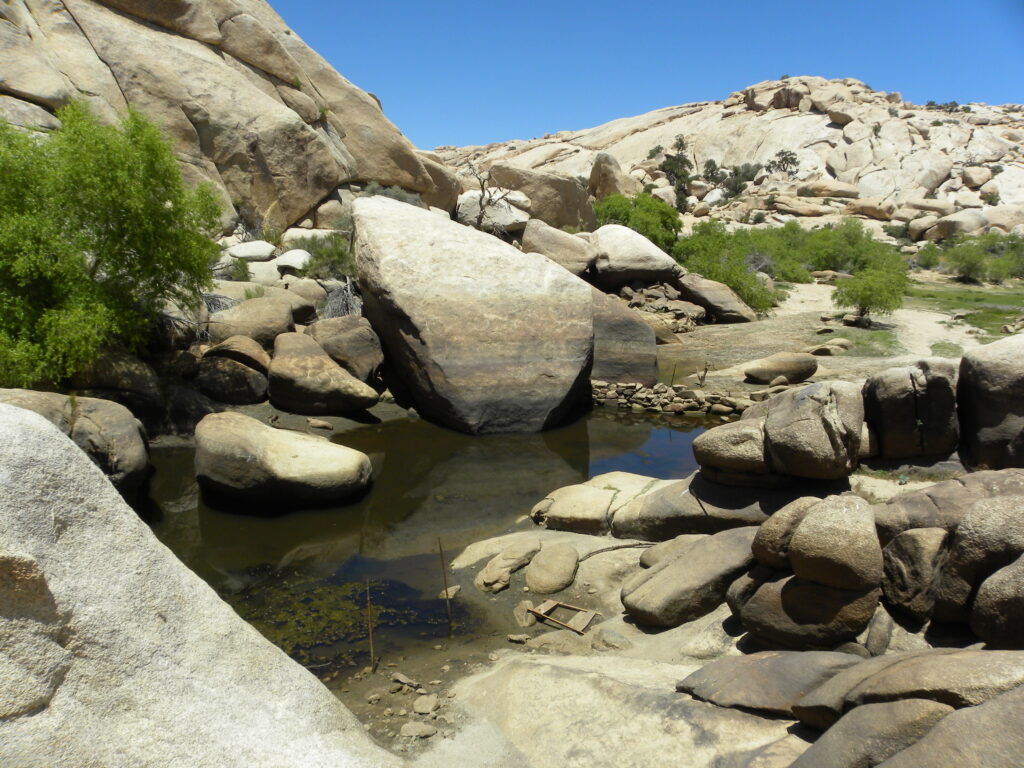
Things to know:
- watch out for rattlesnakes
- be careful where you put your hands and feet – always make sure that there are no snakes in the inter-rock crevices
- watch out for flash floods
- off-road driving is not an option here
- no coverage and no gas stations, so it is worth having a full tank before entering the park.
- before each visit, check the information on the park’s website. From there you will find out, for example, which roads are currently closed or impassable.
Trivia
- Intriguing name: the Joshua tree was given to the plant by a Mormon settler who saw the prophet’s hands raised to heaven in prayer in the characteristic branches of the plant.
- Joshua Tree (Yucca brevifolia) can reach 15 meters in height and up to 200 years old.
- The Joshua Tree is the habitat and refuge for 25 species of desert birds.
- Cacti live in the desert, limiting evaporation, e.g. by reducing the surface of the leaves and covering the assimilation surface with wax that protects against drying out.
Caution:
It is forbidden to light fires, bring dogs, destroy greenery or historic buildings. Separate rules regulate climbing.
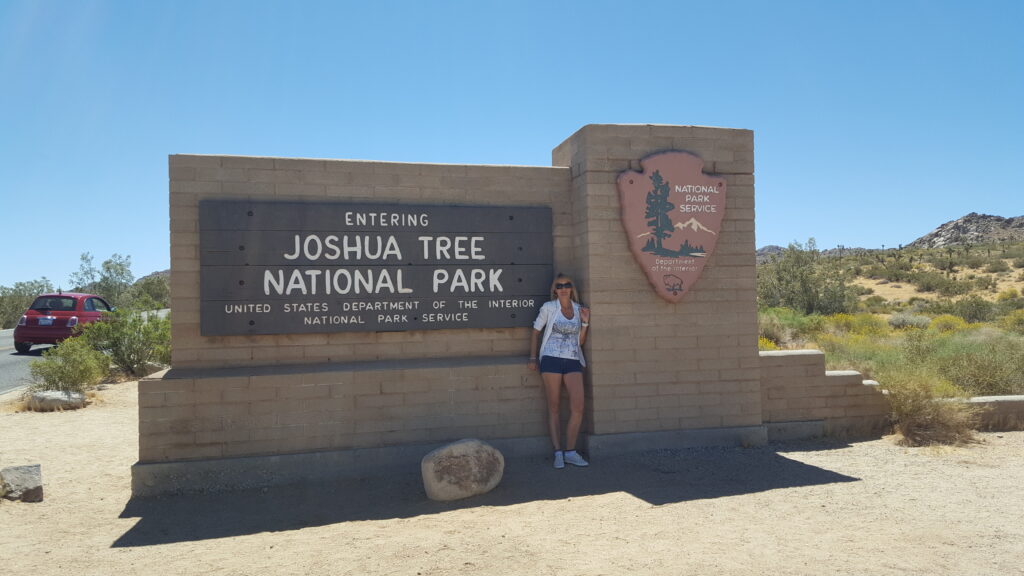
Park Narodowy Joshua Tree (Joshua Tree National Park) leży w południowo-wschodniej części stanu Kalifornia, zaledwie 140 mil (225 kilometrów) od Los Angeles i 49 mil (78 kilometrów) od Palm Springs. Nie jest to na pewno jeden z najbardziej znanych parków USA. Czy zatem warto go odwiedzić? Moim zdaniem tak, nawet jeśli nie jesteście fanami skałkowych wspinaczek. Natomiast dla dla wspinaczy Joshua Tree jest miejscem obowiązkowym. W końcu jest tu ponad 8 tysięcy tras wspinaczkowych.
Drzewo Jozuego i dwie pustynie
Joshua Tree National Park to miejsce, gdzie spotykają się dwie pustynie (Mojave i Kolorado). Oprócz piasku zobaczymy tu niezliczone formacje skalne, a także rośliny, którym park zawdzięcza nazwę. Joshua Tree to drzewo Jozuego albo inaczej jukka krótkolistna. Małe, średnie, duże, powykręcane i kolczaste, rozłożyste i te mniej dorodne. Gdzie nie spojrzymy, tam Joshua trees. I warto się na nie napatrzyć, bo w naturze występują przede wszystkim w stanie Arizona, Kalifornia, Nevada i Utah.
Park można przejechać samochodu, zatrzymując się przy głównych atrakcjach. Od jednej do drugiej wiodą asfaltowe drogi.
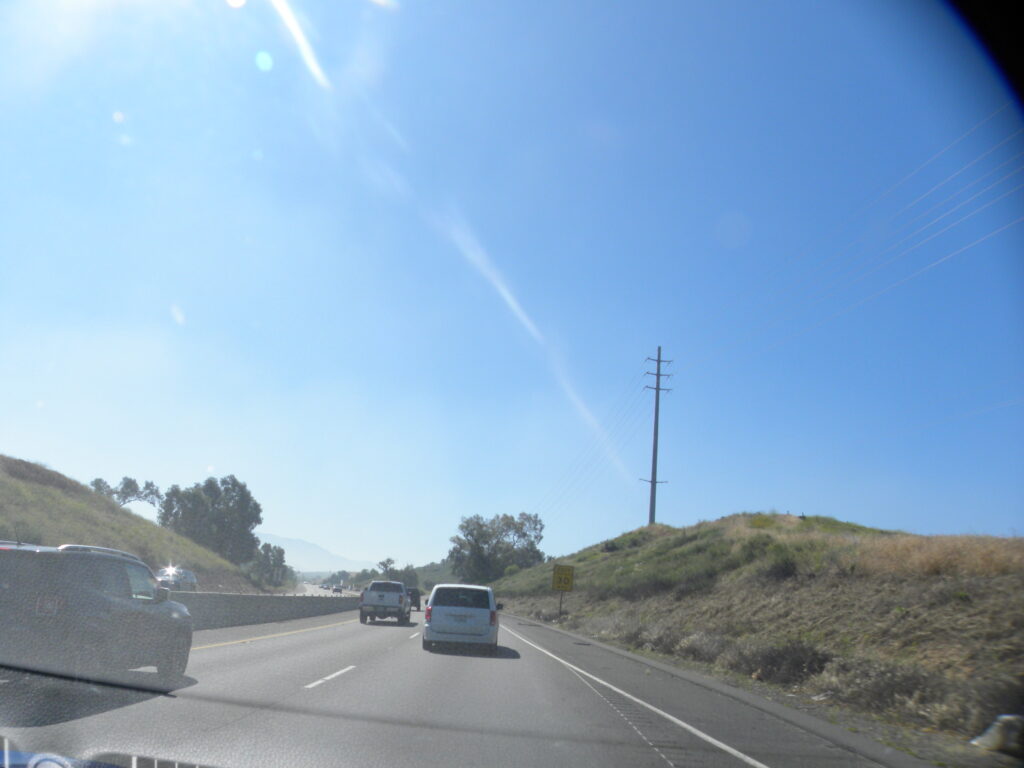
Coraz powszechniejsze staje się zwiedzanie na rowerach. Wynika to z faktu, że ten środek transportu daje się łatwo zapakować do samochodu, daje nam wgląd w obszary niedostępne dla auta i zbyt odległe dla pieszej eksploracji. Nasz kontakt z przyrodą jest pełniejszy, w bardziej odludnych miejscach, dając dodatkową okazję do utrzymywania kondycji fizycznej.
Można też spędzić noc na terenie Joshua Tree (jest tu dziewięć miejsc w których można rozbić namiot), by latem podziwiać rozgwieżdżone niebo. Według niektórych to najlepsze w USA miejsce do wpatrywania się w gwiazdy. A po nocy spędzonej pod rozgwieżdżonym niebem warto powłóczyć się po jednym ze szlaków. A tych – o różnym stopniu trudności – jest niemal 30.
Najlepszym sposobem na poznanie Parku jest wjazd od północnej strony (North Entrance Station), wizyta w ośrodku informacji turystycznej (Oasis Visitor Center), dalszy przejazd do Cholla Cactus Garden i Ocotillo Patch, nawrót, krótki spacer do Arch Rock, przejazd przez Jumbo Rocks i Sheep Pass do zachodniego wjazdu (West Entrance) w Joshua Tree. Taka optymalna trasa, z wypadem na taras widokowy Keys View, liczy zaledwie 100 km zaznajamiając nas dodatkowo z ciekawym fragmentem “niskiej pustyni”.
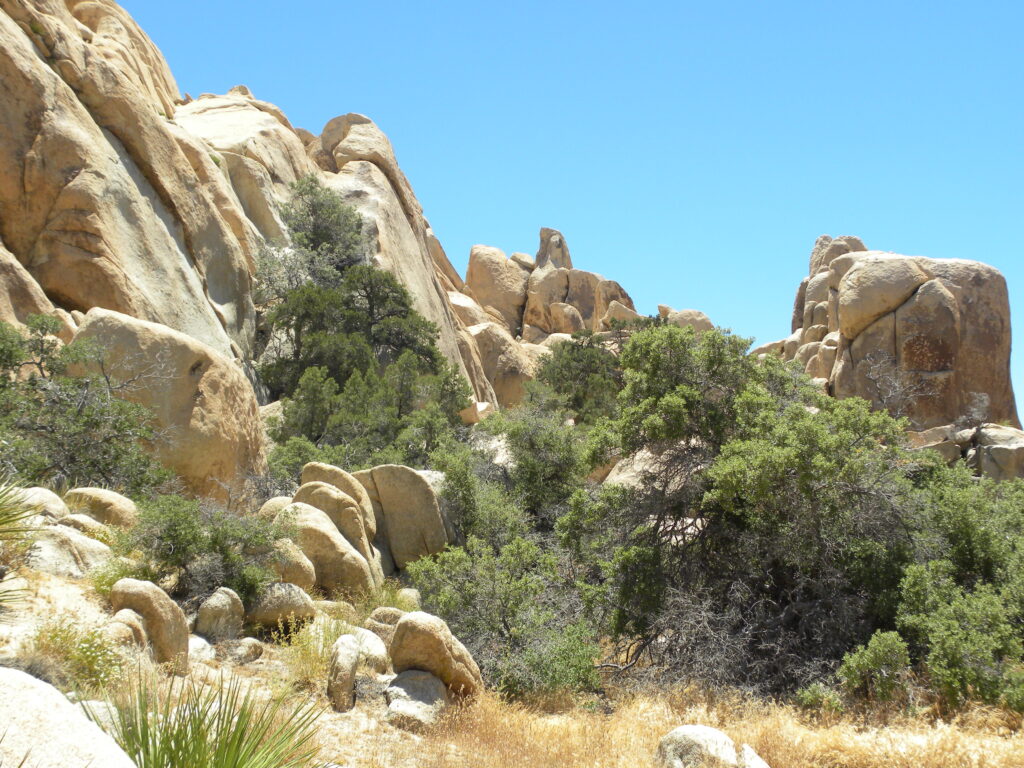
Niedaleko od północnego wjazdu znajduje się zielona, porośnięta palmami oaza (Oasis of Mara), służąca niegdyś Indianom i poszukiwaczom złota za miejsce wytchnienia od palącego słońca. Kilkanaście kilometrów za wjazdem do Parku znajduje się interesujący “ogród” kaktusów cholla (Cholla Cactus Garden). Warto odbyć krótki spacer w tym urzekającym krajobrazie, korzystając z dostępnego przy szosie szkicu ścieżki.
Trzy kilometry dalej na południe jest kolejny przykład zagajnika, tym razem wyglądających jak uniesione do góry wiechcie mioteł kaktusów zwanych owtillo (Ocotillo Patch). Przez większą część roku są to nagie, pokryte kolcami badyle, jednak w marcu i kwietniu porastają zielonymi listkami i jaskrawoczerwonymi kwiatami uwielbianymi przez migrujące z Meksyku kolibry! Ta część Parku wyraźnie reprezentuje pustynię typu Kolorado.
Zawracamy na północ, aby zatrzymać się przy kempingu White Tank, gdzie krótka ścieżka wiedzie do naturalnego skalnego łuku (Arch Rock) z dokładnym opisem geologicznych sił formujących okolicę. Jeszcze ciekawsze przykłady formacji skalnych znajdziemy pośród ogromnych, obleganych przez początkujących alpinistów granitowych głazów (Jumbo Rocks). Jest to najbardziej fotogeniczna część Parku, zważywszy, że nieco dalej, w wąwozie Hidden Valley skały przypominają do złudzenia fantastyczne zwierzęta i ludzkie twarze. To wszystko pośród drzew Jozuego w najpełniejszym rozwoju. Przez Hidden Valley prowadzi 2-kilometrowy szlak, wymagający jednak pewnej wspinaczki po głazach. Od zachodniego wyjazdu z Parku dzieli was tylko 10 km, jeśli jednak macie czas, a smog z Los Angeles nie utrudnia widoczności, warto jeszcze podjechać na wzgórze Keys View, skąd roztacza się panorama Palm Springs, jeziora Salton Sea, gór i pustyń ciągnących się na południe daleko w głąb Meksyku.
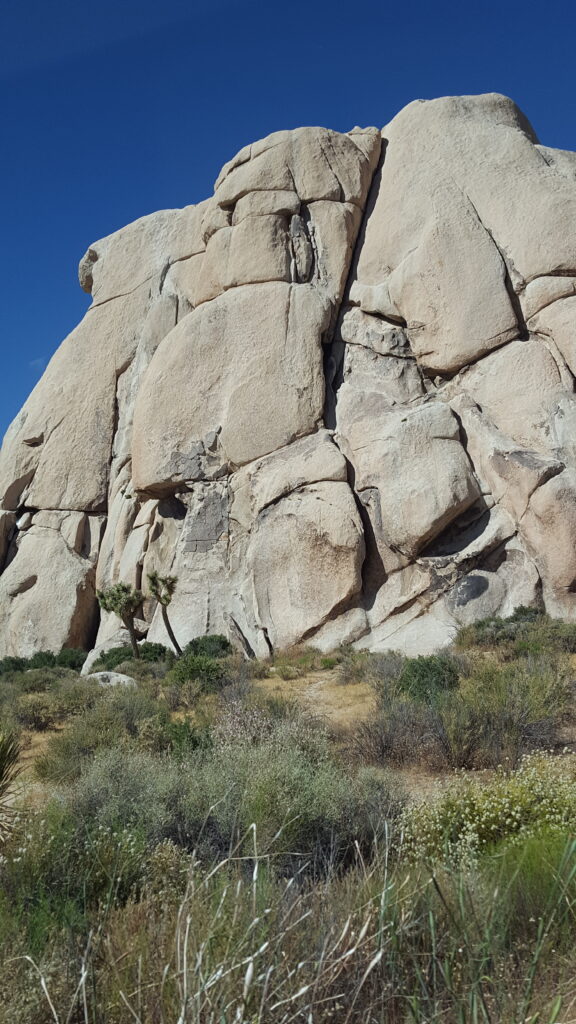
Skały i rośliny to nie wszysto co ma do zaoferowania ten Park. Jeżeli zostaniecie do zmierzchu, możecie usłyszeć jak ożywa martwa na pozór pustynia. Wody jest tak mało, że tylko najbardziej przystosowane do tego klimatu organizmy są w stanie przeżyć, wykazując aktywność głównie w nocy. Wędrując ścieżkami możecie natknąć się na kojoty, zające, skunksy, żółwie pustynne, liczne jaszczurki, grzechotniki, pająki ptaszniki, szczuroskoczki, a z ptaków: kolibry, myszołowy, sowy, sępy i kukawki srokate (roadrunner). Ponoć łatwo tu spotkać pustynne żółwie.
Joshua Tree to park w samym srodku pustyni i panuje tam ogromny upał. My odwiedziliśmy park na początku czerwca I temperatura dochodziła wowczas do 40 stopni Celsjusza. Dlatego koniecznie pamiętajcie o wodzie, kremie z wysokim filtrem i okularach przeciwsłonecznych.
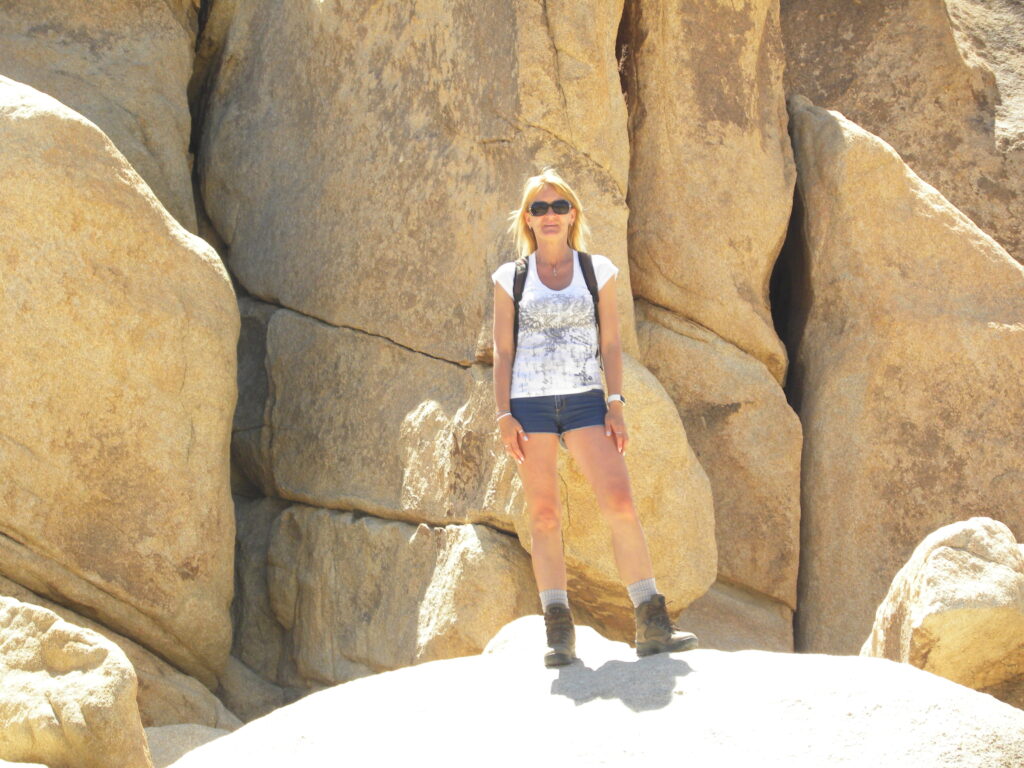
Ile kosztuje wizyta w parku?
Siedmiodniowa wjazdówka do parku to koszt 30 dolarów. Jeśli przyszliście pieszo lub na rowerze to zapłacicie 15 dolarów. Opłata za motor to 25 dolarów. Dla prawdziwych fanów Joshua Tree jest roczna wejściówka, która kosztuje 55 dolarów. Z kolei jeśli w planach macie zwiedzenie większej liczby amerykańskich parków warto zainwestować w, ważną przez rok, kartę “America the Beautiful” (80 dolarów).
Joshua Tree otwarty jest non stop, przez cały rok.
Co warto wiedzieć?
- uważajcie na grzechotniki
- uważajcie, gdzie kładziecie ręce i stawiacie stopy – zawsze upewnijcie się, czy w międzyskalnych szczelinach nie ma węży
- uważajcie na gwałtowne powodzie
- jazda offroadowa nie wchodzi tu w grę
- brak zasięgu i brak stacji bezynowych więc warto mieć pełny bak przed wjazdem do parku.przed każdą wizytą należy sprawdzić informacje na stronie parku. Dowiecie się stamtąd na przykład, jakie aktualnie drogi są zamknięte lub nieprzejezdne.
Ciekawostki
- Intrygująca nazwa: drzewo Jozuego została nadana roślinie przez mormońskiego osadnika, który w charakterystycznych odgałezieniach rośliny widział wzniesione ku niebu w modlitwie ręce proroka.
- Drzewo Jozuego (Yucca brevifolia) może osiągać 15 metrów wysokości i wiek do 200 lat.
- Drzewo Jozuego jest siedliskiem i schronieniem dla 25 gatunków pustynnych ptaków.
- Kaktusy żyją na pustyni ograniczając parowanie m.in. poprzez zmniejszenie powierzchni liści i pokrycie powierzchni asymilacyjnej chroniącym przed wysychaniem woskiem.
Uwaga:
W Parku nie wolno rozpalać ognisk, zabierać ze sobą psów, niszczyć zieleni ani obiektów o charakterze zabytkowym. Odrębne przepisy regulują wspinaczkę.
